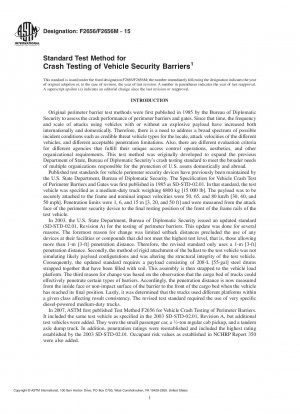ASTM F2656/F2656M-15
Standard Test Method for Crash Testing of Vehicle Security Barriers
- Standard No.
- ASTM F2656/F2656M-15
- Release Date
- 2015
- Published By
- American Society for Testing and Materials (ASTM)
- Status
- Replace By
- ASTM F2656/F2656M-18
- Latest
- ASTM F2656/F2656M-23
- Scope
5.1 This test method provides a structured procedure to establish a penetration rating for vehicle perimeter barriers subjected to a vehicle impact. Knowing the penetration rating provides the ability to select an appropriate barrier for site-specific conditions around a facility.
5.2 The barrier penetration rating does not imply that a barrier will perform as rated in all site conditions, approach routes, and topography. Also, only single-specimen tests at a specified impact location are required by this test method, and therefore, not all points of impact can be tested and validated for the penetration rating. Other impact locations may respond differently.
1.1 This test method provides a range of vehicle impact conditions, designations, and penetration performance levels. This will allow an agency to select passive perimeter barriers and active entry point barriers appropriate for use at facilities with a defined moving vehicle threat. Agencies may adopt and specify those condition designations and performance levels in this test method that satisfy their specific needs. Agencies may also assign certification ratings for active and passive perimeter barriers based on the tests and test methodologies described herein. Many test parameters are standardized to arrive at a common vehicle type and mass, enhance test realism and replication, and produce uniform rating designations.
1.2 Compliance with these test procedures establishes a measure of performance but does not render any vehicle perimeter barrier invulnerable to vehicle penetration. Caution should be exercised in interpreting test findings and in extrapolating results to other than test conditions. While computer simulations are powerful tools that are useful in the development of new and improved barriers or in estimating performance under differing conditions, use of only the results from computer simulation for fielding a product is strongly discouraged. When performing a test, developers and users are encouraged to address specific or unusual site conditions as needed. Often local terrain features, soil conditions, climate, or other items will dictate special needs at specific locations. Therefore, if site conditions are likely to degrade a barrier’s performance, the agency in need of a vehicle perimeter barrier should require testing with the specific site conditions replicated for full-scale crash testing.
1.3 Product/design certification under this test method only addresses the ability of the barrier to withstand the impact of the test vehicle. It does not represent an endorsement of the product/design or address its operational suitability.
1.4 The values in stated in either SI units or inch-pound units are to be regarded separately as standard. The values stated in each system may not be exact equivalents; therefore, each system shall be used independently of the other. Combining values from the two systems may result in non-conformance with the standard.
1.5 This standard does not purport to address all of the safety concerns, if any, associated with its use. It is the responsibility of the user of this standard to establish appropriate safety and health practices and to determine the applicability of regulatory limitations prior to use.
ASTM F2656/F2656M-15 Referenced Document
- ASTM C39/C39M Standard Test Method for Compressive Strength of Cylindrical Concrete Specimens
- ASTM D1556 Standard Test Method for Density and Unit Weight of Soil in Place by the Sand-Cone Method
- ASTM D4429 Standard Test Method for CBR (California Bearing Ratio) of Soils in Place
- ASTM D6938 Standard Test Methods for In-Place Density and Water Content of Soil and Soil-Aggregate by Nuclear Methods (Shallow Depth)
- ISO/IEC 17025 General requirements for the competence of testing and calibration laboratories [Standard in French]
ASTM F2656/F2656M-15 history
- 2023 ASTM F2656/F2656M-23 Standard Test Method for Crash Testing of Vehicle Security Barriers
- 2020 ASTM F2656/F2656M-20 Standard Test Method for Crash Testing of Vehicle Security Barriers
- 2018 ASTM F2656/F2656M-18a Standard Test Method for Crash Testing of Vehicle Security Barriers
- 2018 ASTM F2656/F2656M-18 Standard Test Method for Crash Testing of Vehicle Security Barriers
- 2015 ASTM F2656/F2656M-15 Standard Test Method for Crash Testing of Vehicle Security Barriers
- 2007 ASTM F2656-07 Standard Test Method for Vehicle Crash Testing of Perimeter Barriers
